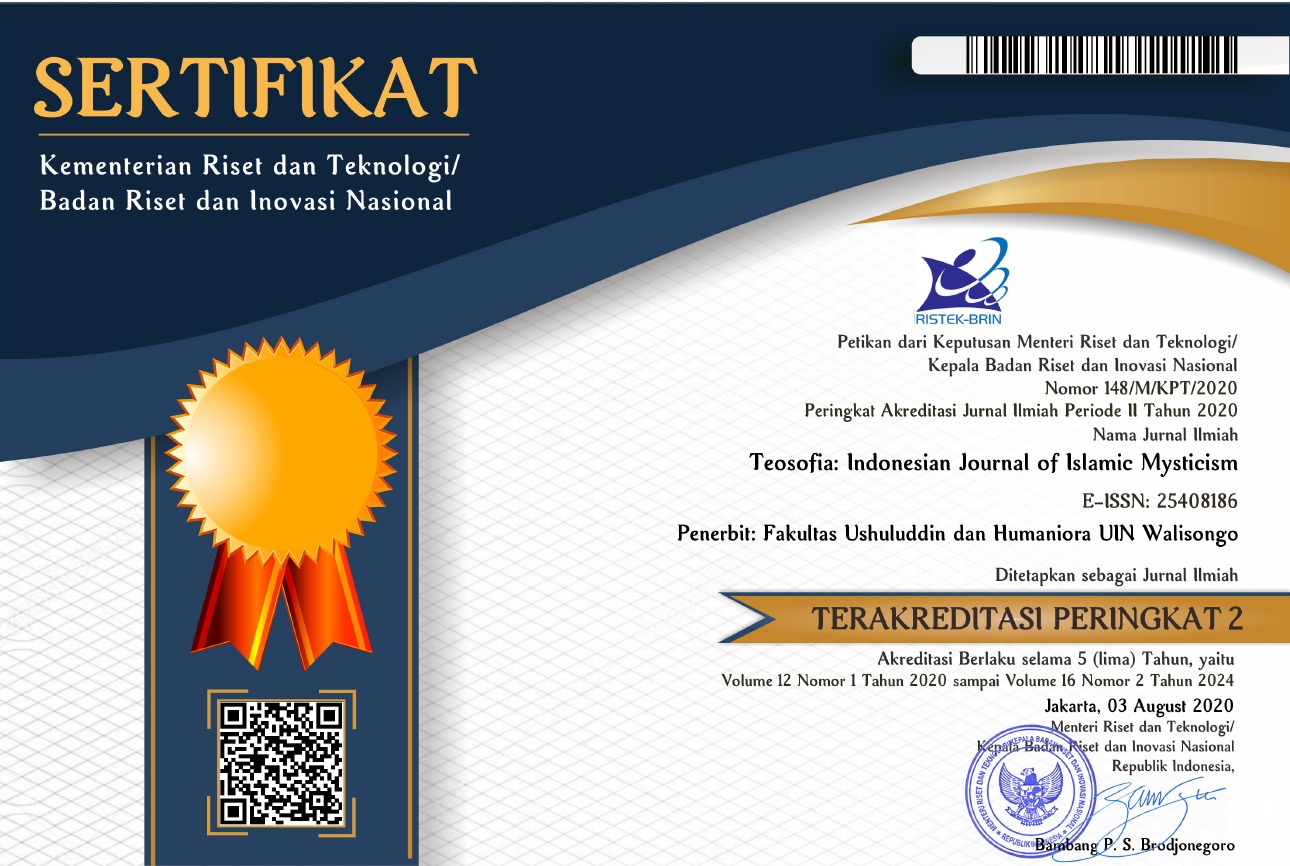Exploring the Connections between Spirituality and Morality: Phenomenology Study on Tijaniyyah Sufi Order’s Congregation in Jatibarang Brebes
DOI:
https://doi.org/10.21580/tos.v6i2.3385Keywords:
spirituality, morality, human behaviour, TijaniyyahAbstract
This article aims at revealing the connections between aspects of spirituality and morality which are able to present happiness and tranquility. One of them is through the approach implicitly implemented in aurad ritual, which is performed by Tijaniyyah sufi order’s congregation at Jatibarang Brebes. It has proven to breaking down the value of the community from bad to good. This phenomenological study, investigates the emergence of the congregation was caused over the human behavior decadence in the midst of modern society. System carried out by Tijaniyyah in renewing the morality of society following the manhaj of prophet Muhammad i.e. through akhlakiyah (ethic) approach. To prove the truth of this Tijaniyyah mission against the moral improvement of society, congregations do a ritual that is lazimah dan wadifah which aims at forming behavior change, especially on its followers. The results of this study show that Tijaniyyah’s congregations at Jatibarang Brebes assert the existence of a sense of serenity in their own life. In addition, they always istiqamah (consistent and commitment) in dealing with any mundane problem.Downloads
References
Abdul Haris, Etika Hamka; Konstruksi Etik Berbasis Rasional Religius, Yogyakarta: LKiS, 2012.
Abdul Mujib, Kepribadian dalam Psikologi Islam, Jakarta: PT. RajaGrafindo Persada, 2007.
Abu al-Wafa al-Ghanimi at-Taftazani, Sufi dari Zaman ke Zaman; Bandung: Penerbit Pustaka, 1997.
Ahmad Amin, Etika (Ilmu Akhlak), Jakarta: Bulan Bintang, 1975.
Ahmad Mahmud Subkhi, Filsafat Etika; Tanggapan Rasionalis dan Intitusionalis Islam, Jakarta: PT. Serambi Ilmu Semesta, 2001.
‘Ali Harazim, Jawahir al-Ma’ani wa Bulugh al-Amani; Fi Faidh Sayyidi Abi al-‘Abbas at-Tijani, Juz I. al-Maghribi: Dar al-Rasyad al-Haditsah, n.d.
Amin Syukur, Menggugat Tasawuf; Sufisme dan Tanggung Jawab Sosial Abad 21, Yogyakarta: Pustaka Pelajar, 1999.
Andre Sponville-Comte, Spiritualitas Tanpa Tuhan, Ciputat-Tanggerang: Pustaka Alvabet, 2007.
G.H. Pijper, FragmentaIslamica; Beberapa Studi tentang Islam di Indonesia Abad ke 20, Jakarta: UI Press, 1987.
H.A.R. Gibb et al. (ed.), Shorter Encyclopedia of Islam, Leiden-New York: E.J. Brill, 1991.
Hamka, Tasawuf Modern, Jakarta: Pustaka Panjimas, 1990.
Henry Bayman, The Secret of Islam; Love and Law in the Religion of Ethics, Berkeley, California: North Atlantic Book, 2003.
Jalaludin, Psikologi Agama; Memahami Perilaku dengan Mengaplikasikan Prinsip-prinsip Psikologi, Jakarta: PT. RajaGrafindo Persada, 2015.
John L., Esposito (ed.), Ensiklopedi Oxford Dunia Islam Modern, Jilid IV, Bandung: Mizan, 2001.
M. Yunus A. Hamid, Thariqah At-Tijaniyyah; Dalam Neraca al-Qur’an dan As-Sunnah, Jakarta: Yayasan Pendidikan dan Dakwah Tarbiyah at-Tijaniyyah, 1430 H..
Muhammad al-‘Arabi al-‘Umari at-Tijani, Bughyah al-Mustafîd, (Brebes: Maktabah Darussalam, tt.).
Muhammad bin Muhammad al-Hajuji al-Hasani, Ittihkaf Ahli al-Maratib al-‘Irfaniyyah bi Dzikri ba’di Rijali at-Tariqati at-Tijaniyyati, Juz. I, www.cheikh-skiredj.com.
Muhammad Ibnu Yusuf, al-Faid ar-Rabbani fi Ba’di al-KhasaisSayyidina Abi ‘Abbas Ahmad ibn Muhammad at-Tijani, (Surabaya: Tanpa Penerbit, 1982).
Roger Walsh, M.D., Essential Spirituality; the 7th Central Practices to Awaken Heart and Mind, New York: John Wiley & Sons, Inc, 1999.
Saepudin, “Review atas tulisan Clyde Kluchkhon dalam Religion Approaching”, Semarang: PPS Walisongo, 2011.
Sri Mulyati, Mengenal dan Memahami Tarekat-tarekat Muktabarah di Indonesia, Jakarta: Prenada Media, 2004.
Stanislav Grof, M.D., & Christina Grof, Spiritual Emergency; When Personal Transformation Becomes a Crisis (ed.), New York: Jeremy P. Tarcher/Putnam a Member of Penguin Putnam Inc., 1986.
Subandi, Psikologi Dzikir; Studi Fenomenologi Pengalaman Transformasi Religius, Yogyakarta: Pustaka Pelajar, 2009.
Taufik Pasiak, Tuhan dalam Otak Manusia; Mewujudkan Kesehatan Spiritual Berdasarkan Neurosains, Bandung: PT. Mizan Pustaka, 2012.
Thomas Patrick Hughes, Dictionary of Islam; Being a Cyclopedia of the Doctrines, Rites, Ceremonies, and Custom, Together with, the Technical and Theological Terms, of The Muhammadan Religion, New Delhi-India: Cosmo Publication, 1982.
Interview with Dasirun informant (street hawker in Tangerang), Mujiharto informant (Civil Servant of Dinas Pengairan and Energi Kabupaten Brebes), and informant Khoeruddin (a teacher at one of the primary schools in Brebes) during routine recitation on Monday 18 January 2015 at Pondok Pesantren Darussalam Jatibarang-Brebes.
Interview with Shaykh al-Habib Muhammad at-Tijani al-Fas and Shaykh Yunus Hamid on the dhikr event together with the Tariqah Tijaniyyah on January 18, 2015 at Pondok Pesantren Darussalam Jatibarang-Brebes.
Downloads
Published
How to Cite
Issue
Section
License
Copyright
The copyright of the received article shall be assigned to the journal as the publisher of the journal. The intended copyright includes the right to publish the article in various forms (including reprints). The journal maintains the publishing rights to the published articles. Therefore, the author must submit a statement of the Copyright Transfer Agreement.*)
Licensing

This work is licensed under a Creative Commons Attribution-ShareAlike 4.0 International License.
In line with the license, authors are allowed to share and adapt the material. In addition, the material must be given appropriate credit, provided with a link to the license, and indicated if changes were made. If authors remix, transform or build upon the material, authors must distribute their contributions under the same license as the original.
_______
*) Authors whose articles are accepted for publication will receive confirmation via email and send a Copyright Transfer Agreement.









